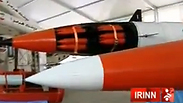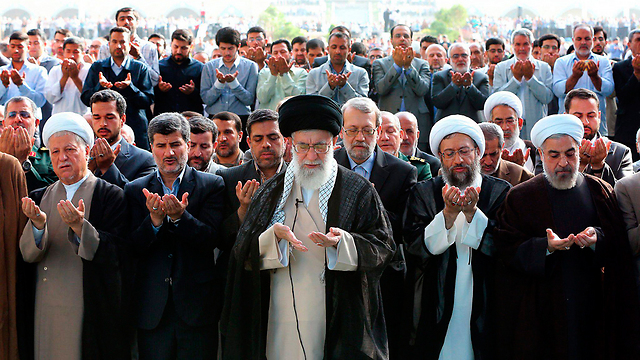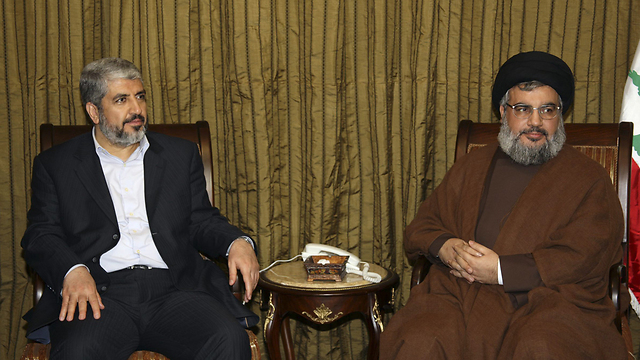
Iran saving Hamas from bankruptcy
Analysis: Islamic organization is sacrificing Gaza's residents in the battle against Israel in order to receive funds and weapons from Tehran.
Tunnels which have been dug for years were bombed by the IDF's Engineering Corps within hours, dozens of the organization's activists were killed every week, and missiles obtained with great effort were mostly "wasted" thanks to the Iron Dome system.
The civilian population in Gaza, which is paying the highest price, is accusing Israel outwardly, but knows very well that Hamas has sacrificed it to advance its goals.
If the defeat is in fact certain and Hamas has hardly reached any achievements, why did it avoid the "hudna" (truce) proposed by Egypt? Why, while the Arab world fails to stand by Hamas and its friends avoid getting involved, are the organization's leaders insisting on their delusional conditions for a ceasefire? The only logical answer can be found in Iran.
'Hashim's Gaza'
Iranian efforts to spread Shia Islam in Gaza have been growing in recent years, quite unsuccessfully. One of the methods is an attempt to endow the city with a religious aura.
The Sunni Hamas organization has dealt more than once with the distribution of Shiite propaganda and even the establishment of Shiite prayer houses in the Gaza Strip.
The Shiite influence has increased since Hezbollah's "victory" in the Second Lebanon War. Most of the Shiite propaganda goes through Hamas' rival, the Islamic Jihad organization, which is ideologically loyal to the Islamic Revolution in Iran.

The Gazans are proud of the city's Arab and Muslim heritage. According to Muslim tradition, Muhammad al-Shafi'I, the founder of one of the four schools of Sunni Islam, is believed to have been born in Gaza in the eighth century.
Hashim, the great-grandfather of Islamic prophet Muhammad, is buried in the ancient northern Gaza. The Hashemites are named after him. According to Sunni Islam, Hashim lived about two generations before the beginning of Islam and was an important and generous merchant. He was an idolater, however. Nonetheless, Sunni dynasties (the Mamluks and Ottomans) respected his heritage and built a mosque in Gaza which they named after him.
Although Gaza is referred to in Islam as "Hashim's Gaza," the Strip's Sunni population is banned from worshipping his grave . Salafi groups in the Strip have attempted in recent years to prevent religious rituals at the gravesite and have even desecrated the tomb.
Shiite elements have tried in recent years to turn Hashim's tomb into a pilgrimage site in order to give the fighting in Gaza a religious nature.
Assad Muhammad Qusayr, an influential Shiite Sheikh from the University of Qom in Iran, who appears on the Arab and Iranian media, called on Muslims to flock to Hashim's grave in December 2013. According to the sheikh, Hashim did not die a natural death in the city on his way back from Mecca, but was murdered by Jews.
According to the Shia, Hashim was not an idolater but a monotheist and even a very righteous person. Several years ago, Hamas curbed a wave of pilgrimage by Shiites from India to Hashim's grave.
Hamas' struggle against the distribution of the Shia is embarrassing the organization and creating a rift with Iran.
The battle against the Shiite propaganda reflects the internal struggle in Gaza between Hamas, which belongs to the Sunni Muslim Brotherhood movement, and the Islamic Jihad, which is loyal to Iran.
There is no doubt that once the IDF operation in the Gaza Strip comes to an end, the tactical alliance between the two organizations will fall apart and the Islamic factions will resume the fighting against each other the Strip's control.
With Iran's help
Hamas' betrayal of the Iranian-Sunni axis during the civil war in Syria sent the organization into a situation of economic and political isolation. Now that it is surrounded by enemies, Israel and Abdel Fattah al-Sisi's Egypt, Hamas has no choice but to court Iran again.
The blocking of the Qatari aid by Saudi Arabia and Egypt and the Iranian failure to continue transferring funds deepened the Gaza-ruling organization's distress and forced its leaders to do everything in order to survive.
Iran was concerned that the "muqawama" (resistance) would die down as a result of Hezbollah's fighting in Syria and began looking for a way to resume terror activities against Israel. Hamas' only way of surviving was to accept Iran's clear demand to resume the fighting against Israel.
This is the deal which likely explains the fighting in the south: Iranian weapons and funding in return for firing missiles at Israel.
According to different reports, the weapons' journey from Iran to Gaza begins when they are loaded on ships which depart from the Bandar Abbas port in southern Iran to the Hormuz Island and travel around the Arabian Peninsula from the south to the Red Sea.
From there, the Syrian-bound shops continue through the Gulf of Suez, while the Gaza-bound vessels are unloaded in Sudan. The weapons are dismantled and led from Egypt and Sinai to through the tunnels to Gaza, where they are reassembled.

Israel has operated several times against ships disguised as commercial vessels. In 2002, Shayetet 13 commandos raided the Karin A ship, in 2011 it was the Victoria ship, and in March is was the Klos C ship in the Red Sea, which was carrying missiles and a lot of ammunition some 1,500 kilometers from the southern resort city of Eilat. Alongside the weapons, the commandos found instructions in Persian and Arabic.
Despite the advanced Israeli intelligence, the siege on Gaza is not hermetic and a lot of Iranian equipment has managed to reach the Strip. Most of it is believed to have been transferred during the term of the Muslim Brotherhood's Mohamed Morsi as Egyptian president from the summer of 2012 to the summer of 2013.
Hamas politburo chief Khaled Mashal praised Iran in an interview from Cairo in November 2012 for its aid to Gaza during Operation Pillar of Defense. Iran's Revolutionary Guards commander, Mohammad Ali Jafari, rushed to deny that Iran was supplying Gaza with missiles, including Fajr-5 missiles which are capable of reaching Tel Aviv and Jerusalem.
But Iranian Parliament Speaker Ali Larijani admitted recently that Iran was supplying Hamas with "weapon-building technology." A huge poster hung on a wall in Gaza recently showed the Palestinian and Iranian flags along with gratitude messages to Tehran in four languages.
Iranian supreme leader Ali Khamenei called on the Palestinians in recent days to expand their struggle from Gaza to the West Bank. The Arab press has reported that Khamenei plans to issue a "fatwa" (Islamic decree) calling on all Muslims to launch a jihad (holy war) against "the Zionist enemy."
Hamas is sacrificing the residents of Gaza in order to receive budgets and weapons from Iran and maintain its leadership among the Islamic factions. The war killing Gaza's residents is saving Hamas from bankruptcy and loss of control.
Dr. Yaron Friedman, Ynet's commentator on the Arab world, is a graduate of the Sorbonne. He teaches Arabic and lectures about Islam at the Technion, at Beit Hagefen and at the Galilee Academic College. His book, "The Nusayri Alawis: An Introduction to the Religion, History and Identity of the Leading Minority in Syria," was published in 2010 by Brill-Leiden.










